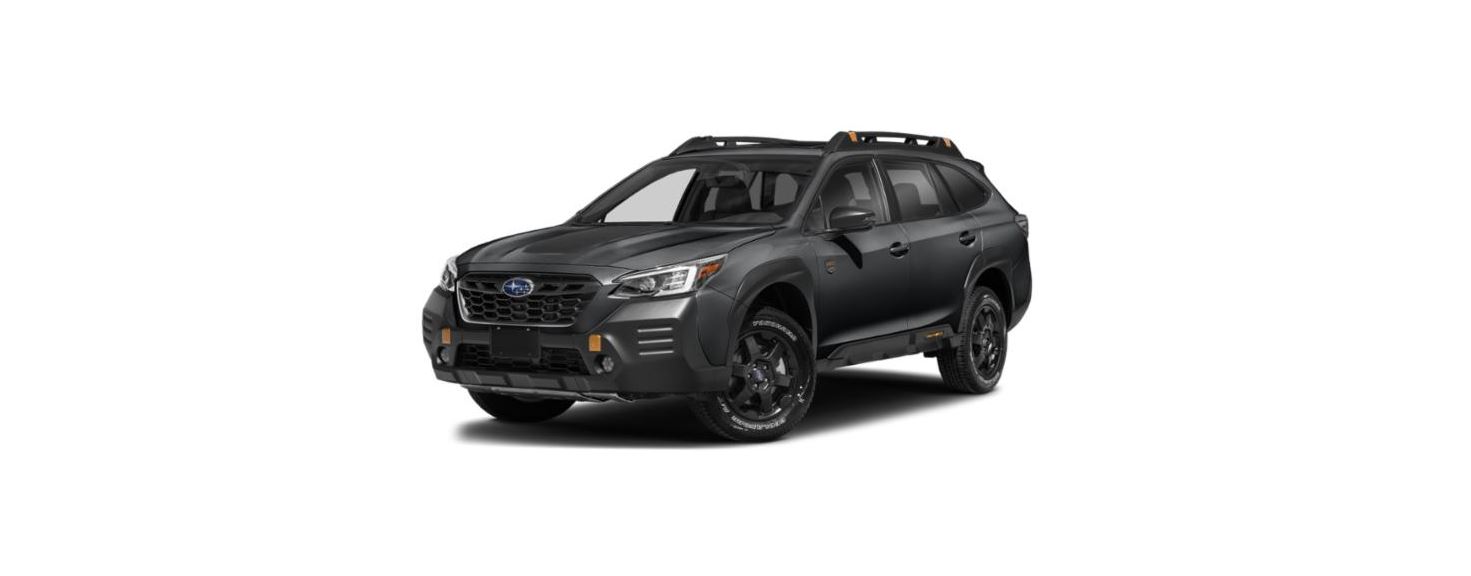2022 Subaru Outback Light Control Switch
Light Control Switch
CAUTION
- Use of any lights for a long period of time, while the engine is not running, can cause the battery to discharge.
- Before leaving the vehicle, make sure that the light control switch is turned to the off position. If the vehicle is left unattended for a long time with the light control switch set to a position other than the off position, the battery may be discharged.
Models with “keyless access with push-button start system”:
The light control switch operates when the push-button ignition switch is in the “ACC” or “ON” position.
Regardless of the position of the light control switch, the illuminated lights are turned off when the push-button ignition switch is turned off.
Models without “keyless access with push-button start system”:
The light control switch operates when the key is inserted in the ignition switch. Regardless of the position of the light control switch, the illuminated lights are turned off when the key is removed from the ignition switch.
NOTE
The light control switch can be operated (except auto on/off headlights), even under the following conditions.
- When the push-button ignition switch is turned off (models with “keyless access with push-button start system”)
- When the key is not inserted into the ignition switch (models without “keyless access with push-button start system”)
If the driver’s door is opened while the headlights are illuminated under such conditions, a chirp sound will inform the driver that the lights are illuminated.
Headlights
Except for Canada models
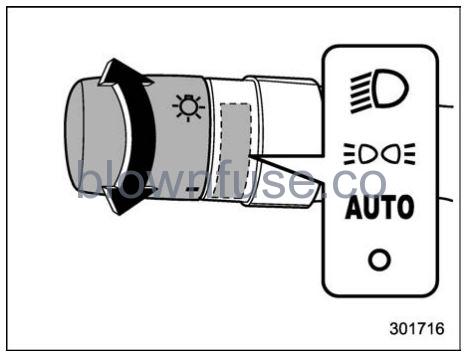
For Canada models
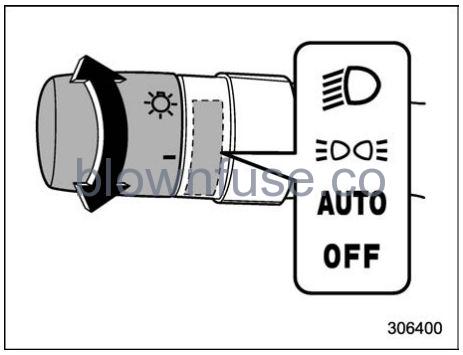
To turn on the headlights, turn the knob on the end of the light control switch.
![]() position (except for Canada models):
position (except for Canada models):
The headlights are all off.
“OFF” position (for Canada models):
The headlights are all off *1*2.
- When the light switch is switched to the “OFF” position while the vehicle is stopped, the lights turn off. Then the light switch will automatically return to the “AUTO” position.
- The headlights will automatically change to the AUTO mode when the following conditions are met:
- The engine is running.
- The parking brake is fully released.
- The select lever is in a position other than the “P” position.
![]() position:
position:
Instrument panel illumination, headlights, parking lights, front side marker lights, rear side marker lights, tail lights and license plate lights are on.
![]() position:
position:
Instrument panel illumination, parking lights, front side marker lights, rear side marker lights, tail lights and license plate lights are on.
![]() position: Auto on/off headlights
position: Auto on/off headlights
When the ignition switch is in the “ON” position, the instrument panel illumination, headlights, parking lights, front side marker lights, rear side marker lights, tail lights and license plate lights are automatically on or off depending on the level of the ambient light.
NOTE
- If the light control switch is in the “AUTO” position and the headlights do not turn on when it becomes dark outside, turn the light switch to the
 position. If this happens, have your vehicle inspected by your SUBARU dealer as soon as possible.
position. If this happens, have your vehicle inspected by your SUBARU dealer as soon as possible. - The light sensitivity of the auto on/off headlights can be changed by operating the center information display. For details, refer to “Car settings” P223 (11.6-inch display models) or “Vehicle setting icons” P242 (dual 7.0-inch display models). Also, the setting can be changed by a SUBARU dealer. Consult your SUBARU dealer for details.
Auto-on/off wiper-linked headlights
While the light control switch is in the “AUTO” position, the headlights will automatically turn on when the windshield wipers operate several times. The headlights will automatically turn off approximately 1 minute after the wiper stops.
The ON/OFF setting of this function can be changed by operating the center information display. For details, refer to “Car settings” P223 (11.6-inch display models) or “Vehicle setting icons” P242 (dual 7.0-inch display models). Also, the setting can be changed by a SUBARU dealer.
Consult your SUBARU dealer for details.
Welcome lighting function
The welcome lighting function turns on the low beam headlight for smooth approaching to or exiting from the vehicle at night or in a dark place.
The function is activated while all of the following conditions are met.
- The light control switch is in the “AUTO” position.
- It is dark enough to turn on the auto-on/off headlights.
NOTE
If the engine is turned off after turning off the light switch, the welcome lighting function may not operate (for Canada models).
When approaching
While the welcome lighting function is activated, the low beam headlights will automatically illuminate when unlocking the doors (for Outback/Subaru Outback Wilderness, including the rear gate) by using the remote keyless entry system.
The low beam headlights will remain illuminated for 30 seconds*1 and then turn off. However, if any of the following operations is done, the low beam headlights will turn off.
- The doors are locked.
- The light control switch is turned to a position other than “AUTO”.
- The ignition switch is turned to the “ON” position.
When exiting
While the welcome lighting function is activated, the low beam headlights will remain illuminated even when either of the following operation is done.
- The push-button ignition switch is turned to the “OFF” status (models with “keyless access with push-button start system”).
- The key is pulled out from the ignition switch (models without “keyless accesswith push-button start system”). The low beam headlights will turn off under any of the following conditions.
- 3 minutes have passed since the low beam headlights were illuminated by the welcome lighting function.
- 30 seconds have passed since the door is opened and closed.*1
- The light control switch is turned to a position other than “AUTO”.
- The locking procedure is performed twice. When performing the unlocking procedure after performing the locking procedure, perform the locking procedure twice again.
The setting for the period of time in which the low beam headlights remain on by the welcome lighting function can be changed by a SUBARU dealer. Contact your SUBARU dealer for details. Also, you can change the setting by operating the center information display. For details, refer to “Car settings” P223 (11.6-inch display models) or “Vehicle setting icons” P242 (dual 7.0- inch display models).
Sensor for the auto on/off headlights
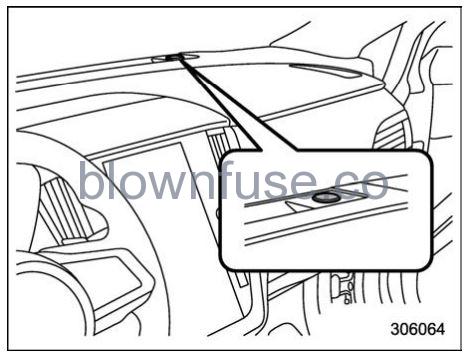
The sensor is on the instrument panel as shown in the illustration.
CAUTION
If any object is placed on or near the sensor, the sensor may not detect the level of the ambient light correctly and the auto on/off headlights may not operate properly.
High/Low Beam Change (Dimmer)
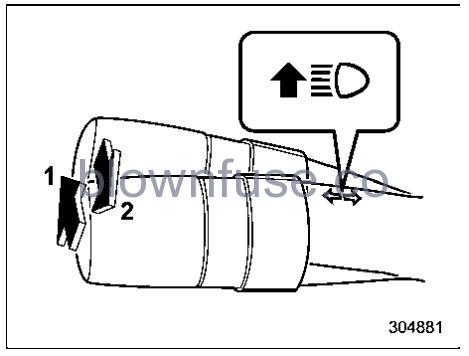
- High beam
- Low beam
While the light control switch is in the ![]() or
or ![]() position in a dark place, the headlights will turn on.
position in a dark place, the headlights will turn on.
When the headlights are on high beam, the high beam indicator light ![]() on the combination meter is also on.
on the combination meter is also on.
NOTE
While the light control switch is in the ![]() position and the lever is the high beam position, the high beam assist function will be on standby.
position and the lever is the high beam position, the high beam assist function will be on standby.
Headlight Flasher
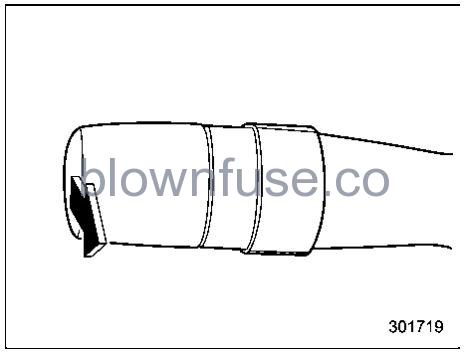
CAUTION
Do not hold the lever in the flashing position for more than just a few seconds.
To flash the headlights, pull the lever toward you and then release it. The high beam will stay on for as long as you hold the lever. The headlight flasher works even though the lighting switch is in the off position.
When the headlights are on high beam, the high beam indicator light ![]() on the combination meter also illuminates.
on the combination meter also illuminates.
High Beam Assist Function
NOTE
- The high beam assist function utilizes the stereo camera installed at the position of the front map lights.
- For details on how to handle the stereo camera, refer to the Owner’s Manual supplement for the EyeSight system.
The high beam assist function automatically changes the headlight from high beam to low beam (or vice versa).
When all of the following conditions are met, the headlight will change to high beam.
- When the vehicle speed increases to or above 20 mph (32 km/h).
- There is no preceding or oncoming vehicle.
- The forward area of the vehicle is dark.
- The road does not have a sharp curve. When any of the following conditions are met, the headlight will change to low beam.
- When the vehicle speed decreases to or below 10 mph (16 km/h).
- When the forward area of the vehicle is bright.
- When there is a preceding or oncoming vehicle.
- When the EyeSight system is malfunctioning or is temporarily stopped.
NOTE
- Do not overestimate the capacity of the high beam assist function. The driver always has the responsibility to understand the surrounding situation, to drive safely, and to change the headlight mode manually if necessary.
- The factory setting (default setting) for this function is set as “operational”.
This setting can be changed to OFF (non-operation) at SUBARU dealers. For more details, contact a SUBARU dealer.
How to use the high beam assist function
The high beam assist function will be activated when all the following conditions are met.
- The light control switch is in the “AUTO” position and the low beam headlights are on automatically.
- The turn signal lever is pushed forward.
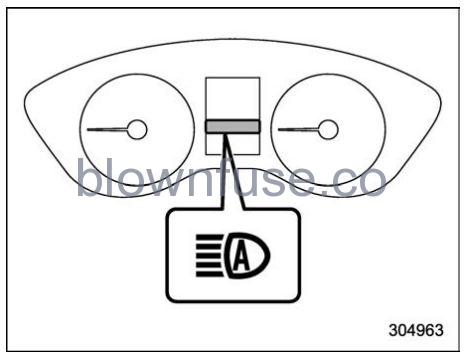
High beam assist indicator
When the high beam assist function is activated, the high beam assist indicator on the combination meter will illuminate.
NOTE
If the high beam assist function is malfunctioning or is temporarily stopped, the headlight will be fixed at low beam.
Temporary stop of high beam assist function
If the high beam assist function stops temporarily due to poor visibility or abnormal temperature, the message appears on the combination meter. Once the conditions have been remedied, drive the vehicle for a while to restore the system.
NOTE
Even when the operation conditions of the high beam assist function are met, there may be a case in which the high beam assist indicator does not illuminate.
How to temporarily lower the sensitivity of the high beam assist function
The sensitivity of the high beam assist function can be lowered by using the following operations.
- Before turning the ignition switch to the “ON” position, set the light control switch to the “AUTO” position and push the signal lever forward (high beam position).
- Turn the ignition switch to the “ON” position and within approximately 15 seconds, press the
 (following distance setting) switch more than 10 times consecutively.
(following distance setting) switch more than 10 times consecutively.
When the sensitivity of the high beam assist function is lowered, the high beam assist indicator light ![]() on the combination meter display (color LCD) will flash.
on the combination meter display (color LCD) will flash.
NOTE
- The sensitivity of the high beam assist function cannot be lowered in the following conditions.
- The cruise control or Adaptive Cruise Control indicator is illuminated.
- The EyeSight warning indicator (yellow) is illuminated.
- The sensitivity of the high beam assist function returns to a normal level the next time the ignition switch is turned to the “LOCK”/“OFF” position and the engine is restarted.
How to change the headlight mode manually
- Change to the low beam: When you return the turn signal lever to the center position, the high beam assist function will turn off and the high beam assist indicator will turn off.
- Change to the high beam: When you turn the light control switch to the
 position, the headlight mode will be changed to the high beam. At this time, the high beam assist function will turn off, the high beam assist indicator will turn off and the high beam indicator light will turn on.
position, the headlight mode will be changed to the high beam. At this time, the high beam assist function will turn off, the high beam assist indicator will turn off and the high beam indicator light will turn on.
NOTE
- After manually changing the headlight mode to the high beam, if you turn on the high beam assist function, return the light control switch to the “AUTO” position.
- When manually changing the headlight mode to the high beam, if you turn the light control switch to the
 position, the parking lights, front side marker lights, rear side marker lights, tail lights and license plate lights will turn on.
position, the parking lights, front side marker lights, rear side marker lights, tail lights and license plate lights will turn on.
Tips for the high beam assist system
- The high beam assist function recognizes the condition surrounding the vehicle based on the brightness of illumination ahead of your vehicle, etc. Therefore, the headlight mode may switch in some situations that do not match to the driver’s sense.
- A bicycle or cargo cycle may not be detected.
- Under the following situations, the brightness of ambient illumination may not be detected correctly and the high beam assist function may not work properly. As a result, the glare of the high beam may disturb the oncoming vehicle or vehicle ahead. Also, the low beam mode may continue although there are no oncoming vehicles and vehicles ahead. In the such cases, change the headlight mode manually.
- In bad weather (fog, snow, sand storm, heavy rain, etc.).
- When the windshield glass is dirty or fogged.
- When the windshield is cracked or damaged.
- If there are lights similar to the headlights or the tail lights in the surrounding area.
- When an oncoming vehicle or vehicle ahead is driven without its headlights and tail lights on.
- If the headlights of an oncoming vehicle or the tail lights of a vehicle ahead are dirty or discolored, or if the light beams are not aimed correctly.
- When a rapid change of brightness continues while driving.
- When driving on a road with many ups and downs or uneven surfaces.
- When driving on a road with many curves.
- When there are some objects that reflect light strongly, such as a road sign or a mirror in vehicle ahead.
- When the rear part of the vehicle ahead, such as a container, reflects light strongly.
- When the headlights of your vehicle are damaged or dirty.
- When your vehicle is tilted, such as in case the vehicle has a flat tire or is being towed.
- When the stereo camera is deformed or the stereo camera lenses are dirty.
- Immediately after the engine has started.
- In the following conditions, the headlight mode will not be automatically changed from the high beam to the low beam.
- When your vehicle passes an oncoming vehicle suddenly in a blind curve.
- When another vehicle passes in front of your vehicle.
- When an oncoming vehicle or vehicle ahead comes in and out of view because of continuous curves, median strips, roadside trees, etc.
- If the stereo camera detects the light of the front fog lights of an oncoming vehicle, the headlight mode may change from the high beam to the low beam automatically.
- The headlight mode may change from the high beam to the low beam, or the low beam mode may continue, when affected by a street light, traffic signal, illumination of an advertisement board, or a reflective object such as a road sign and signboard.
- The timing of the change of headlight mode may differ due to the following factors.
- Color or brightness of the headlights of an oncoming vehicle or the tail lights of a vehicle ahead.
- The headlights of the oncoming vehicle or the tail lights of the vehicle ahead are covered with mud, snow, etc.
- Movement and direction of an oncoming vehicle or a vehicle ahead.
- When the headlights of an oncoming vehicle or the tail lights of a vehicle ahead illuminate on only one side.
- When the oncoming vehicle or vehicle ahead is a motorcycle.
- Conditions of a road (slope, curve, road surface, etc.).
- Number of passengers and weight of loaded cargo.
- Limitation of the detection ability of the stereo camera.
Daytime Running Light System
WARNING
W0hen the daytime running lights are illuminated, the tail lights do not illuminate. When it becomes dark outside, turn the light switch to the ![]() position to illuminate the headlights and tail lights. This will improve visibility and allow other drivers to see your vehicle more easily.
position to illuminate the headlights and tail lights. This will improve visibility and allow other drivers to see your vehicle more easily.
The daytime running lights will automatically illuminate when the following conditions are fulfilled.
- The engine is running.
- The parking brake is fully released.
- The light control switch is in the “AUTO”,
 or
or  position (except for Canada models).
position (except for Canada models). - The light control switch is in the “AUTO”,
 or “OFF” position (for Canada models).
or “OFF” position (for Canada models). - The select lever is in a position other than the “P” position.
NOTE
When the light switch is in the ![]() position, the instrument panel illumination, front side marker lights, tail lights and license plate lights are also illuminated.
position, the instrument panel illumination, front side marker lights, tail lights and license plate lights are also illuminated.
